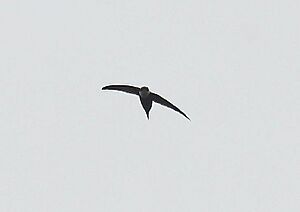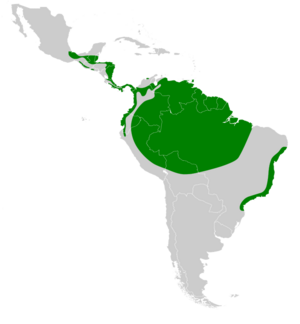Lesser swallow-tailed swift facts for kids
Quick facts for kids Lesser swallow-tailed swift |
|
|---|---|
 |
|
| Conservation status | |
| Scientific classification | |
| Genus: |
Panyptila
|
| Species: |
cayennensis
|
 |
|
The lesser swallow-tailed swift or Cayenne swift (Panyptila cayennensis) is a small, speedy bird. It is part of the swift family, known for their incredible flying abilities. You can find this swift in many places. Its home ranges from southern Mexico all the way through Central America. It also lives in most mainland South American countries, but not Argentina, Chile, Paraguay, or Uruguay. You can even spot it on the island of Trinidad.
Contents
About the Lesser Swallow-tailed Swift
The lesser swallow-tailed swift was first officially described in 1789. A German scientist named Johann Friedrich Gmelin gave it its scientific name. He first placed it in the same group as swallows. Later, scientists moved it to a different group called Panyptila. This name comes from Ancient Greek words meaning "very" or "exceedingly" and "wing." The name cayennensis comes from Cayenne, French Guiana. This is where the first bird specimen was found.
Scientists usually agree that there are no different types (subspecies) of this swift. It is considered a single species.
What Does It Look Like?
The lesser swallow-tailed swift is a slim bird. It is about 12.7 to 13 centimeters (5 inches) long. It weighs around 18 grams, which is very light! This swift has long, narrow wings. It also has a long, forked tail. This tail is usually held closed, making it look pointed.
Most of its body is black. But it has a white throat and upper chest. It also has white square-shaped patches on its sides, near its tail. Both male and female swifts look the same.
Where Does It Live?
You can find the lesser swallow-tailed swift in many places. Its range starts in eastern Mexico. It then goes south through all of Central America. It continues into Colombia, Venezuela, and Ecuador. This swift also lives across the entire Amazon Basin. You can find it in a thin strip along Brazil's southeastern coast too. It also lives on the island of Trinidad.
These birds like to live in tropical forests. They prefer the edges of forests or clearings. You might also see them in areas where people live or farm. They can live at elevations up to 1,500 meters (about 4,900 feet). However, they are usually found closer to sea level.
Swift Behavior
Movement and Flight
The lesser swallow-tailed swift stays in the same area all year round. It does not migrate. These birds are known for their incredibly fast flight. They often fly very high up in the sky. Their flight can look fluttery and quick.
What Do They Eat?
Like all swifts, the lesser swallow-tailed swift catches insects while flying. This means they are "aerial insectivores." They eat bugs right out of the air! While their exact diet isn't fully known, studies show they mostly eat flies. They also eat smaller numbers of other insects like plant-hoppers and wasps.
These swifts are not as social as some other swift species. You usually see them alone or in pairs. If other swifts are around, the lesser swallow-tailed swift often flies above them to find food.
Reproduction and Life Cycle
The breeding season for the lesser swallow-tailed swift changes depending on the area. Generally, they nest during the local spring and summer. Their nest is shaped like a tube. It is wider at the top, and the entrance is at the bottom.
They build their nests using plant material. They stick it together with their own saliva. The nest is then attached to a branch or a flat, vertical surface. This could be a wall or a tree trunk. Nests have been found under bridges, on buildings, or inside empty buildings. They also build them on large trees. The female swift lays two or three white eggs. Both parents take turns sitting on the eggs to keep them warm.
Swift Calls
The lesser swallow-tailed swift has a unique call. It sounds like a reedy or wheezy phrase. It's a fast series of twittering notes. You might hear something like "pzeee-pzi-titititititi-ti-ti-pzeee!" They also make a repeated, drawn-out single "pzeeeh." These birds often fly so high that their calls can be hard to hear.
Conservation Status
The IUCN (International Union for Conservation of Nature) has looked at the lesser swallow-tailed swift. They have listed it as a species of "Least Concern." This means it is not currently in danger of disappearing. The bird lives in a very large area. Scientists estimate there are at least 500,000 adult birds.
While the population seems to be slowly getting smaller, there are no immediate major threats. In some parts of its range, it is considered uncommon. In other places, it is fairly common. You usually see them in small groups.


